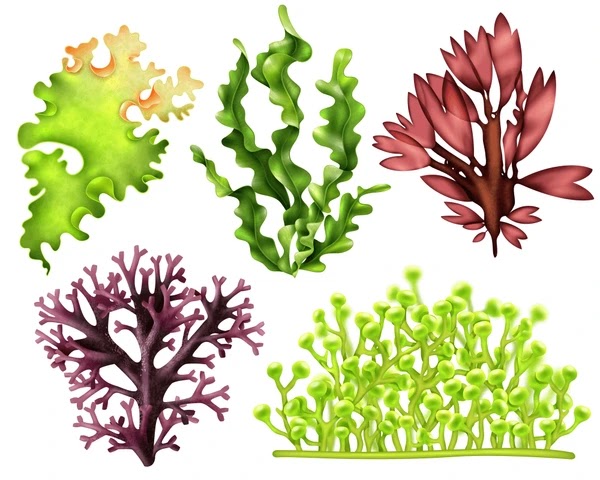Understanding Algae Life Cycles: A Comprehensive Exploration
Introduction
Algae, a diverse group of photosynthetic organisms, exhibit a wide array of life cycles. Each type of life cycle reflects the unique reproductive strategies that algae employ to adapt to their environment. In this article, we will delve into the details of various algae life cycles, including haplontic, diplontic, diplohaplontic, haplodiplobiontic, and haplobiontic life cycles.
Haplontic Life Cycle
The haplontic life cycle is characterized by a predominant haploid phase in the organism's life. In this cycle, the haploid phase, represented by a single set of chromosomes, is the dominant and independent stage. Algae exhibiting a haplontic life cycle undergo mitosis to produce haploid spores, which then develop into mature haploid individuals. Examples of algae with haplontic life cycles include many green and red algae.
Diplontic Life Cycle
Conversely, the diplontic life cycle is distinguished by a dominant diploid phase. In this cycle, the organism spends the majority of its life in a diploid state, characterized by two sets of chromosomes. Diplontic algae reproduce through meiosis, producing haploid gametes that fuse during fertilization, giving rise to a diploid zygote. Brown algae, such as kelp, are known for their diplontic life cycles.
Diplohaplontic Life Cycle
The diplohaplontic life cycle, also known as the haplodiplontic life cycle, is a combination of both haploid and diploid phases, with each being multicellular and independent. This cycle involves alternation of generations, where the haploid and diploid phases take turns in dominating the life cycle. Green algae, like Ulva, commonly exhibit diplohaplontic life cycles.
Haplodiplobiontic Life Cycle
The haplodiplobiontic life cycle is a variation where both haploid and diploid stages are multicellular and independent. This complex life cycle involves three distinct multicellular phases: haploid gametophyte, diploid sporophyte, and a diploid gametophyte. Some red algae, such as Polysiphonia, showcase haplodiplobiontic life cycles.
Haplobiontic Life Cycle
The haplobiontic life cycle, in contrast, is a simpler cycle with only one multicellular phase, either haploid or diploid, being the dominant stage. This straightforward life cycle involves mitosis for the production of spores or gametes, depending on whether the organism is haploid or diploid. Certain green algae, like Chlamydomonas, exhibit haplobiontic life cycles.
Significance and Adaptations
Understanding these varied life cycles provides insights into the adaptability and resilience of algae in different environments. The choice of life cycle often relates to the environmental conditions, enabling algae to thrive in diverse habitats. Whether it's the simplicity of haplobiontic life cycles or the complexity of diplohaplontic life cycles, each adaptation serves a specific purpose in the survival and reproduction of these remarkable organisms.
Conclusion
In conclusion, the exploration of haplontic, diplontic, diplohaplontic, haplodiplobiontic, and haplobiontic life cycles in algae reveals the fascinating diversity in reproductive strategies within this group of organisms. The ability to switch between haploid and diploid phases, or maintain a predominant phase, highlights the adaptability of algae to changing environmental conditions. As we continue to unravel the intricacies of algae life cycles, we gain a deeper appreciation for their role in maintaining ecological balance.
Frequently Asked Questions(FAQs)
Q: What is the significance of understanding different algae life cycles?
- A: Understanding different algae life cycles provides insights into their reproductive strategies, adaptability, and resilience, contributing to broader ecological knowledge and environmental conservation efforts.
Q: Are all algae capable of alternating between haploid and diploid stages in their life cycles?
- A: No, not all algae exhibit alternation of generations. The ability to alternate between haploid and diploid stages depends on the specific life cycle strategy adopted by each algal species.
Q: How do environmental factors influence the choice of life cycle in algae?
- A: Environmental factors such as light, temperature, and nutrient availability play a crucial role in shaping the reproductive strategies of algae. These factors can influence whether algae adopt haplontic, diplontic, or other life cycles.
Q: Can algae switch between different life cycles based on environmental conditions?
- A: Algae may exhibit some degree of flexibility in their life cycles in response to changing environmental conditions. However, the extent of this flexibility varies among different algal species.
Q: Do all algae species follow one of the mentioned life cycles, or are there exceptions?
- A: While the mentioned life cycles are common among algae, exceptions exist. Some algae may have unique variations or combinations of life cycle phases, showcasing the diversity within this group of organisms.
Q: Why are algae life cycles important to study?
- A: Algae life cycles play a crucial role in understanding the ecological dynamics and adaptive strategies of these organisms.
Q: How do algae adapt their life cycles to environmental changes?
- A: Algae exhibit various strategies in their life cycles to adapt to factors such as temperature, light, and nutrient availability.
Q: Are there any commercially valuable algae with unique life cycles?
- A: Yes, certain algae species with specific life cycles are utilized in various industries, contributing to commercial applications.
Q: What are the challenges researchers face in studying algae life cycles?
- A: Methodological challenges and gaps in understanding present obstacles for researchers studying algae life cycles.
Q: How can understanding algae life cycles contribute to environmental conservation?
- A: Understanding algae life cycles aids in formulating conservation strategies, considering their roles in ecosystems.
- You may also like these
- Introduction to cyanobacteria
- Nostoc
- Oscillatoria
- Anabaena












0 Comments